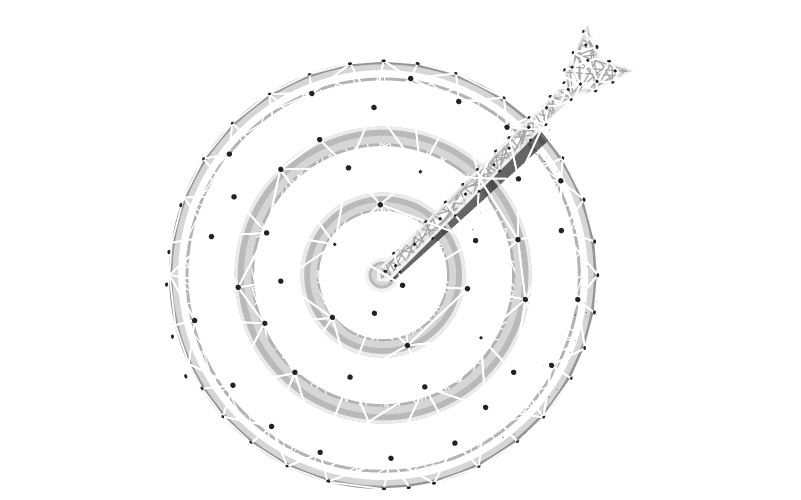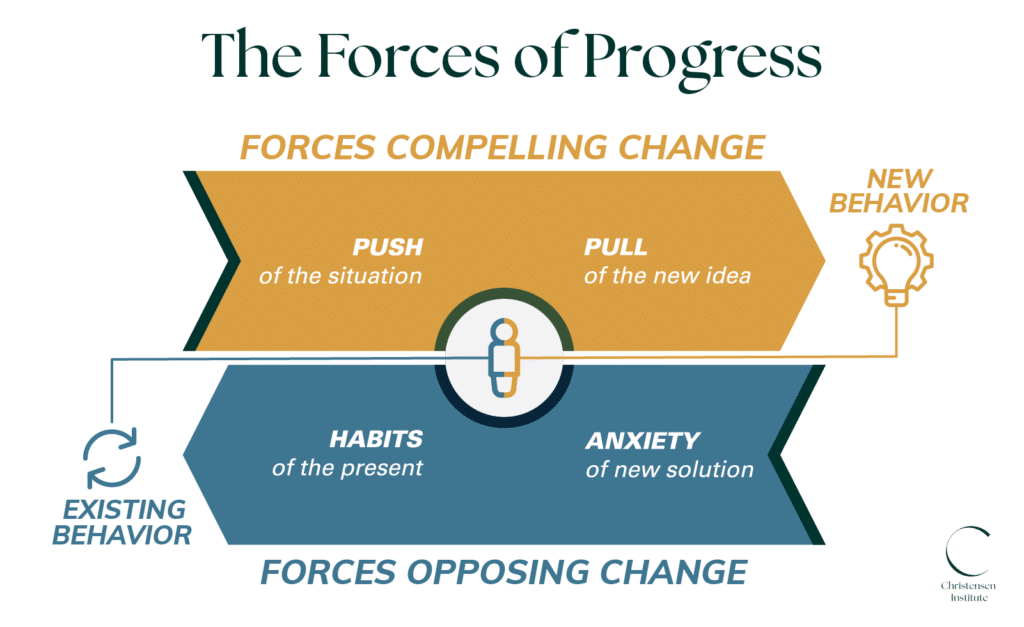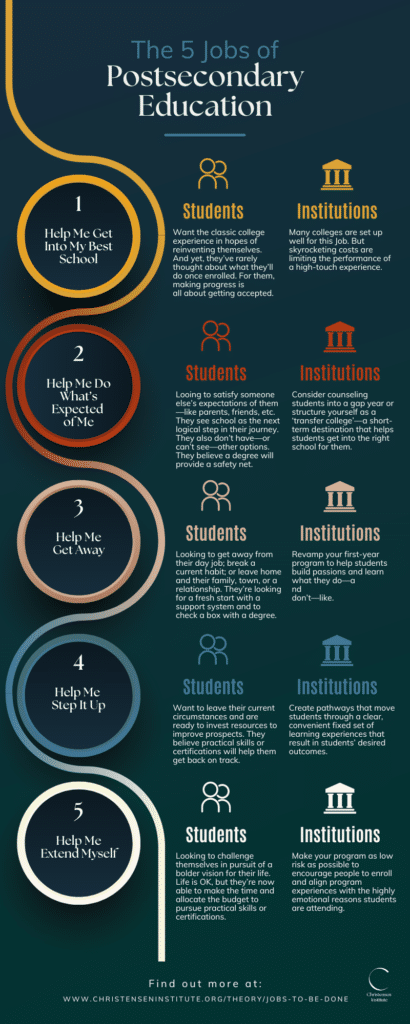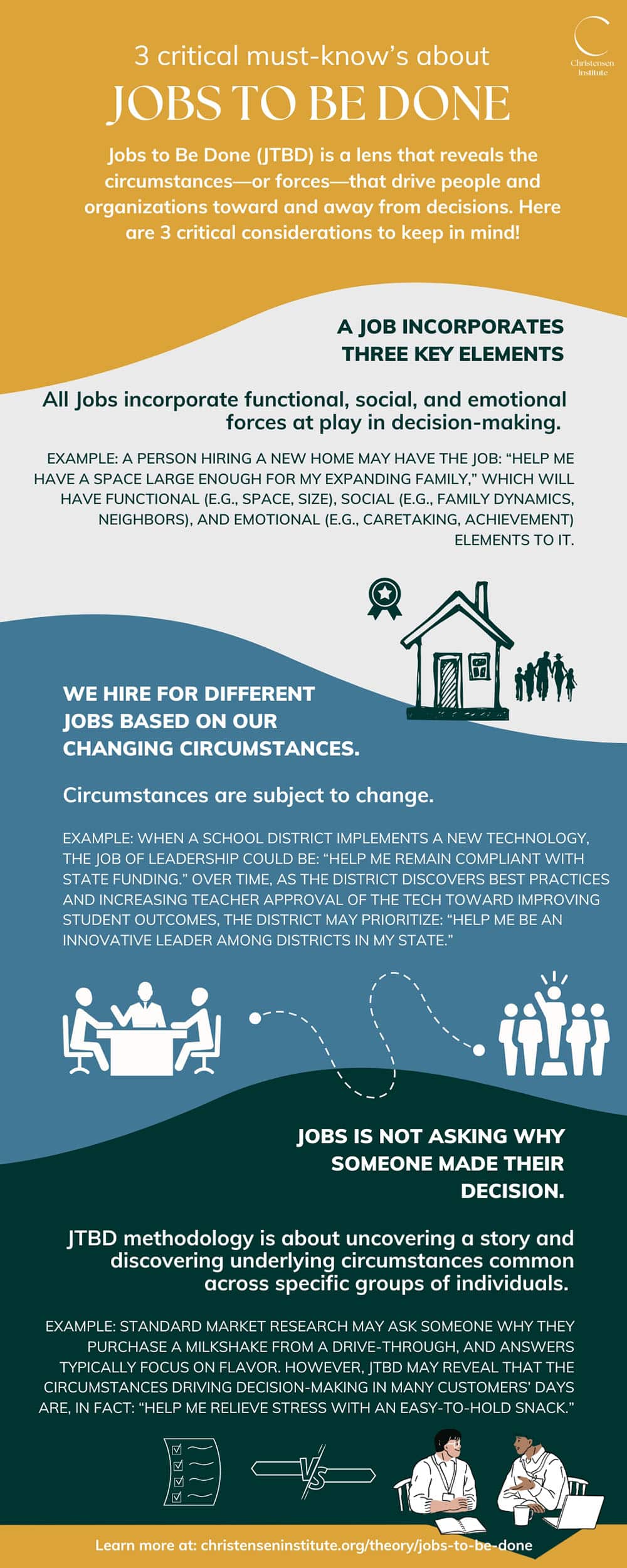Jobs to Be Done Theory
The theory that helps innovators understand how and why people make decisions.

Definition
Jobs to Be Done is a lens that reveals the circumstances—or forces—that drive people and organizations toward and away from decisions.
While conventional marketing focuses on market demographics or product attributes, Jobs to Be Done Theory (JTBD or Jobs Theory) goes beyond superficial categories to expose the functional, social, and emotional dimensions that explain why people make the choices they do.
Everyone has Jobs to Be Done in their lives—the progress they’re trying to make as they strive toward a goal or aspiration within particular circumstances.
We call these Jobs because just as people hire contractors to help them build houses or lawyers to build a case, people “hire” products or services when “jobs” arise in their lives.

Unique Insight
People don’t simply buy or pick products or services; they pull them into their lives to make progress.
Explainer
What’s the value of applying a Jobs to Be Done Theory lens? And how does it compare to using demographic data, market assumptions, and competitive analyses? Check out our video to find out.
Case Studies
Helpful Tools
Infographic: Three critical must-knows
Jobs to Be Done (JTBD) is a lens that reveals the circumstances—or forces—that drive people and organizations toward and away from decisions. Here are 3 critical considerations to keep in mind!
A job incorporates three key elements.
All Jobs incorporate functional, social, and emotional forces at play in decision-making.
Example: A person hiring a new home may have the job: “Help me have a space large enough for my expanding family,” which will have functional (e.g., space, size), social (e.g. family dynamics, neighbors), and emotional (e.g., caretaking, achievement) elements to it.
We hire for different Jobs based on our changing circumstances.
Circumstances are subject to change.
Example: When a school district implements a new technology, the job of leadership could be: “Help me remain compliant with state funding.” Over time, as the district discovers best practices and increasing teacher approval of the tech toward improving student outcomes, the district may prioritize: “Help me be an innovative leader among districts in my state.”
Jobs is not asking why someone made their decision.
JTBD methodology is about uncovering a story and discovering underlying circumstances common across specific groups of individuals.
Example: Standard market research may ask someone why they purchase a Milkshake from a drive-through, and answers typically focus on flavor. However, JTBD may reveal that the circumstances driving decision-making in many customers’ days are, in fact: “Help me relieve stress with an easy-to-hold snack.”
At the Clayton Christensen Institute, we’re using Jobs to Be Done Theory to:

Help Nigerians access electricity
Nigeria has the largest energy deficit in the world. Because solar energy is affordable long-term and renewable, it’s considered one of the main ways Nigeria could reach its electricity goals. But adoption of solar energy is slow-going. Understanding why solar energy adoption isn’t happening as quickly as one would expect through the lens of Jobs to Be Done will help innovators better address these barriers and develop solar products and services that better fit the functional, emotional, and social needs of Nigerians.

Support innovative health care business leaders
What do people really want from health care? In her podcast, “Life-Centered Health Care,” Ann Somers Hogg chats with Jay Gerhart, Vice President, Innovation Engine at Atrium Health about how understanding patients’, consumers’, and customers’ Jobs to Be Done can help health care providers and leaders understand what their patients really want.

Understand the growing demand for microschools
Public school districts across the US have lost over one million students since 2020. Meanwhile, novel educational models—such as microschools and hybrid homeschooling—have more than doubled their enrollments. What’s driving families to new learning environments? Interviews with parents who recently moved their children to microschools uncovered three Jobs to Be Done.







